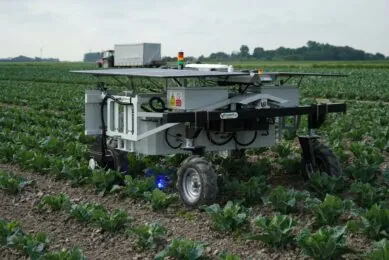Robots in agriculture: How to know if it is a good investment?

Agricultural robotics is a fascinating and fashionable subject. In the face of dangers threatening agriculture, robots show their utility and ambitions. But what is the reality? Should you invest in agricultural robotics? And if the answer is yes, how to invest? What return on investment can you expect? Here are 3 things to consider before deciding to purchase a robot.
1: The maturity of the product
This criterion will depend on your expectations and needs. For the moment, only milking robots have reached a certain stability and technological maturity. The agricultural robots that evolve in our fields, weeding, seeding, spraying, or harvesting, are still at the beginning of their commercialisation, or even in development phase. And when thinking about buying a robot, it is important to understand what phase the product is in.
The longer you wait for a product to mature, the more you can be sure that the product will be reliable and require little maintenance. There will be fewer constraints with the product and the return on investment will be faster.
The earlier you invest in a technology, the more you can directly impact the development of the product by becoming a privileged partner. the robot can then be adapted to the specific problems you face and your operation will be ahead in its development.
2: The costs of implementation
The automation of agricultural tasks represents an enormous potential in the long term, but there are implementation costs to be considered. To be able to calculate these costs, you must look at several things:
- Be aware of the constraints of using the robot and make sure that they correspond to your farm and the current crop configurations. This will give you an idea of the area of action of the robot and the investments needed to implement this solution.
- Find out about the complexity of the machine, how it works and how to adjust it to identify the training and personnel needed for the robot to work properly.
- Think about the logistical aspect. If robots are autonomous, usually they cannot access the plot by themselves like a tractor. It is also necessary to find out about the level of autonomy of the machine, its recharging, and the time needed to adjust it. If you have the possibility to organise a demonstration on your farm, it is the perfect opportunity to study this criterion.
With these data, you have all information you need to calculate the profitability threshold.
3: Calculate the break-even point
The price of a field robot varies according to its capacities and its field of action. From $ 20,000 for a few hectares of capacity, to $ 500,000 for a capacity of several dozen hectares.
To make the robot profitable, it is necessary to focus on high-value crops such as vineyards, market gardening, orchards, and berries. With these crops, you must identify repetitive tasks that are costly in terms of time and/or manpower, as the robots on the market are often focused on these niches. Then, it is important to calculate the cost of the current solution, considering the globality of the costs and their evolution: machine costs, labour costs, productivity, operating costs…
The same thing must be done with the solution proposed by the robot, in terms of purchasing costs, productivity, daily autonomy, operating costs, implementation… If it seems less obvious, you can get help from a specialist. Once all the data is gathered, you can compare the two solutions and see where the break-even point of the project is.
Text continues below image

In conclusion
Making the choice to robotize your farm is a long-term investment, so there are many more things to consider when buying a field robot. Like the fact that thetechnology is still young and far from having reached its full capacity. Who can predict where the development of robotics will end?
Join 17,000+ subscribers
Subscribe to our newsletter to stay updated about all the need-to-know content in the agricultural sector, two times a week.



